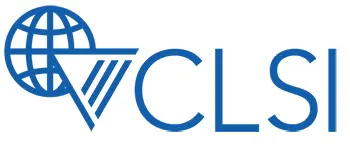CLSI: Clinical And Laboratory Standards Institute

CLSI, the Clinical and Laboratory Standards Institute, is a nonprofit organization that develops and publishes standards serving the health care industry. Headquartered near Philadelphia, United States, CLSI standards, through the over 2,000 organizations and 2,000 individuals in the CLSI membership base, have greatly influenced the current state of its field on an international level. CLSI is the secretariat of ISO/TC 212 (International Organization for Standardization/Technical Committee), as well as serving as the administrator for the U.S. TAGs (United States Technical Advisory Group) to ISO/TC 212 and its WGs (Working Groups). Standards from CLSI are available both individually, directly through the ANSI webstore, and as part of a Standards Subscription. If you or your organization are interested in easy, managed, online access to standards that can be shared, a Standards Subscription may be what you need - please contact us at: [email protected] or 1-212-642-4980 or Request Proposal Price.
Below are CLSI's best-selling standards. To find additional standards, please use the search bar above.
CLSI EP25-A Vol. 29 No. 20
Diagnostic Reagents; Approved Guideline Stability of In Vitro Diagnostic Reagents; Approved Guideline
This document provides guidance for establishing shelf-life and in-use stability claims for in vitro diagnostic reagents such as reagent kits, calibrators, and control products.
CLSI POCT1-A2
Point-of Care Connectivity: Approved Standard-Second Edition
This standard establishes a set of specifications to allow seamless multivendor interoperability and communication between point-of-care devices, data concentrators, and clinical information systems. CLSI document POCT1 provides the framework for engineers to design devices, workstations, and interfaces that allow multiple types and brands of point-of-care devices to communicate bidirectionally with access points, data concentrators, and laboratory information systems from a variety of vendors.
As an interface standard, this document specifies the common communication interfaces and protocols between systems and devices. It facilitates the transfer of data to support the creation of point-of-care applications, services, and institutional policies. This document does not directly address specific pointof- care application and service level functions, such as device lockout and operator list management. This document specifies protocol, not policy. The interfaces specified support the communication required for engineers to build such application-level functionality. Specifying, building, and providing the applications to support these services are left to customers, device and information system vendors.
The only relationship of this point-of-care standard to the laboratory automation domain is through the use of the HL7 standard. In version 2.4,1 the HL7 standard was expanded to provide elements essential to laboratory automation, which also improved the HL7 standard for the entire laboratory-testing domain. These additions to HL7, along with four proposed new HL7 message triggers (see Section 4.1 in Appendix C of this CLSI standard), enable the point-of-care community to use HL7 as its electronic data interchange (EDI).
This specification also leverages several communication standards. It specifies the use of a single device transport protocol (IrDA TinyTP) running over two possible physical layers: IrDA-infrared, as specified by the Infrared Data Association (IrDA) and ISO/IEEE 11073-303002; and cable-connected, as specified by the IEEE 1073 lower-layers standard.3 This specification also utilizes local area networking standards such as IEEE 802.34 and protocols such as TCP/IP in cases where network connectivity is required.
CLSI EP17-A2
Evaluation of Detection Capability for Clinical Laboratory Measurement Procedures; Approved Guideline -Second Edition (EP17-A2)
This document provides guidance for evaluation and documentation of the detection capability of clinical laboratory measurement procedures (ie, limits of blank, detection, and quantitation), for verification of manufacturersÆ detection capability claims, and for the proper use and interpretation of different detection capability estimates.
CLSI C24-Ed4
Statistical Quality Control for Quantitative Measurement Procedures: Principles and Definitions, 4th Edition
This guideline provides definitions, principles, and approaches to laboratory quality control design, implementation, and assessment.
CLSI EP06
Evaluation of Linearity of Quantitative Measurement Procedures - 2nd Edition (This document replaced EP06A)
This guideline provides information for characterizing the linearity interval of a measurement procedure, validating a linearity interval claim (to be performed by the manufacturer), and verifying an established linearity interval claim (to be performed by the end user).
CLSI EP07-Ed3
Interference Testing in Clinical Chemistry - 3rd Edition
This guideline provides background information, guidance, and experimental procedures for investigating, identifying, and characterizing the effects of interferents on clinical chemistry test results.
CLSI EP09c
Measurement Procedure Comparison and Bias Estimation Using Patient Samples - 3rd Edition
This guideline covers the design of measurement procedure comparison experiments using patient samples and subsequent data analysis techniques used to determine the bias between two in vitro diagnostic measurement procedures.
CLSI EP28-A3C
Defining, Establishing and Verifying Reference Intervals in the Clinical Laboratory; Approved Guideline - Third Edition
This document contains guidelines for determining reference values and reference intervals for quantitative clinical laboratory tests. A CLSI-IFCC joint project.. The U.S. Food and Drug Administration (FDA) has evaluated and recognized this approved-level consensus guideline for use in satisfying a regulatory requirement. This document is included in the CLSI document code change and rebranding that is currently in process. The code will be changed from C28-A3c. Please make sure that the document title corresponds to the publication that you intend order
CLSI M40-A2 (R2019)
Quality Control of Microbiological Transport Systems; Approved Standard - Second Edition
This document provides criteria to assist manufacturers and end users of transport devices in providing and selecting dependable products for the transport of microbiological clinical specimens.
CLSI EP05-A3 (R2019)
Evaluation of Precision of Quantitative Measurement Procedures; Approved Guideline - Third Edition
This document provides guidance for evaluating the precision performance of quantitative measurement procedures. It is intended for manufacturers of quantitative measurement procedures and for laboratories that develop or modify such procedures.





